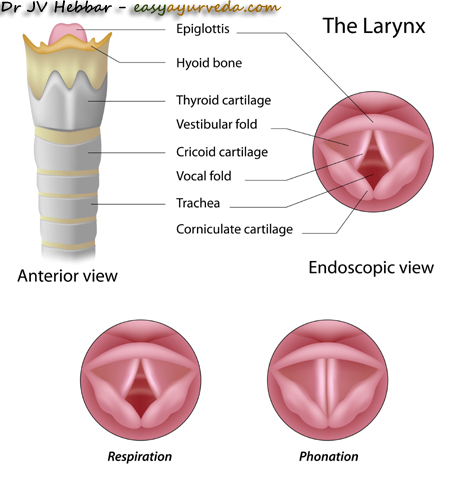Role of Vata Dosha And Its Types In Speech And Voice
Article by Dr Raghuram Y.S. MD (Ay) & Dr Manasa, B.A.M.S
Speech is the language of expression. Speech conveys many things we want to convey, including our emotions and feelings. We present present ourselves through the language of our speech. At the same time our speech should be meaningful, with right words put in right places and used with lot of precision, according to situation.
Vak Pravrutti – Speech patterns are carried out by the involvement, motivation and stimulation from Udana Vata, a type of Vata Dosha.
Along with Udana, the other types of Vata Dosha co-ordinate in the process of speech production.
Read related – Udana Vayu – Location, Functions, Symptoms of vitiation
Table of Contents
Udana Vata Functions
Normal Functions of Udana Vayu
- Vak Pravritti – Production of speech, phonation, articulation
- Prayatna – Enables efforts towards doing day to day activities
- Urja – Provides energy
- Bala – Provides strength, immunity and endurance
- Varna – Provides good color
- Smriti – Enhances memory power

Production of Speech
Production of speech by Udana Vayu
Vak Pravritti (Bhashita) – Speech, phonation are controlled by Udana Vayu. It is located in the chest and it travels in the throat, where vocal cords are present and aids in the production of speech. The activation of speech apparatus by Udana Vayu will make speaking possible. The words and syllables are pronounced properly with the help of Udana Vayu.
Therefore the language and proper formation of words and meaningful sentences is also under the control of Udana Vayu.
Since Udana Vayu is located in the chest, which is the site of heart and lungs, the vitiation of Udana Vata will disturb the functions of heart and lungs. This will lead to deficit blood supply and oxygenation to all parts of the body, including the vocal apparatus.
When the vocal apparatus is not supplied by sufficient nutrition, they go weak and the sound or speech is hampered leading to feeble, scanty, mild and tired voice.
This explains why the voice changes or becomes tired and sick when the person has heart problems and lung disorders or disorders of breathing, like bronchitis, asthma etc.
Read related: 6 Quick Natural Remedies To Improve Singing Voice
Prana and Udana Vata Coordination
Coordination of Udana Vayu and Prana Vata in the production of speech
Prana Vayu also moves in the chest region. Therefore the cooperation of Prana Vayu with Udana is essential for normal breathing function.
Similarly Prana Vayu also has its territory in the kantha (throat).
The speech is thus produced by coordinated functions of Prana and Udana Vayu.
The balance of inspiration (handled by Prana Vayu) and expiration (handled by Udana Vayu) is also essential for normal speech and phonation. Since Prana is located in the head, it is said to control the speech centers in the brain and since Udana is located in the chest, it is said to have a local control over speech production. Therefore the integrity between Prana and Udana Vayu is very essential for the speech production.
Read related: Hoarse Voice Causes, Ayurvedic Treatment, Home Remedies
Role of Agni
Role of Agni, Udana aSamana Vayu in the production of speech:
The coordination of Samana Vayu which is near the Agni Sthana (digestive apparatus, stomach, intestines) and Udana is essential for speech production. Agni – digestive fire is said to participate not only in digestion and other activities of metabolism plus speech.
The mechanism of speech production as narrated by Acharya Panini in his book ‘Paaniniya Shiksha’ is as follows.
Read related: Laryngitis (Swelling of voice box) – Causes, Ayurvedic Treatment
Speech production sequence
Sequence of production of speech, Ayurvedic perspective
Decision by Atma (soul) and Buddhi (intellect) – The soul when combined with intellect takes a decision whether to speak or not. The decision is also taken regarding what to speak.
Activation of Manas
Activation of Manas (mind) – After these initial decisions about how and what to speak is made in concurrence with Atma and Buddhi, they simulate the mind.
Stimulation of Agni
Activation and stimulation of Agni – Digestive fire –
The mind, stimulated and propelled by intellect and soul, further motivates the digestive fire. This fire is in the form of Pachaka Pitta and is very close to the Samana Vata.
The coordination and proper synchronization of Samana Vayu and Agni will enable proper digestion of food and formation of nutritive essence i.e. ahara rasa which is responsible to nourish and form all the dhatus or tissues of the body. Thus, when the manas stimulates the agni, it also stimulates and activates the samana vayu.
Read related: Kanthya Gana: Voice Improving Herbs: Review, Benefits, Formulations
Udana Vata stimulation
Stimulation of Udana Vayu – The digestive fire, thus stimulated will further go on to stimulate the Udana Vayu.
Production of Vak
Upward movement of Udana Vayu and production of Vak – This Udana Vata which is situated in the navel region, chest, throat and nasal cavity, move in the direction of its normal and natural course, i.e. upward direction and produces sound and voice.
In the production of voice and sounds, we thus see the mutual coordination between the Udana Vayu and Samana Vayu along with the digestive fire Agni.
Thus, the Udana-Samana axis is also important for the production of voice.
Thus, the udana vata guided by atma, buddhi, and manas, moves in upward direction and on reaching nose and throat, stimulates the movements of the structures of oral cavity and produce different words like anunasika shabda (words from the nose), taluja shabda (words articulated from the palate), khantam shabda (words articulated from the throat) etc.
We would have also seen that the voice gets weak and debilitated when we do not take the food or during fasting (as the fire i.e. agni and samana vayu do not receive the fuel in the form of food). This also points towards the sync between Samana Vayu and Udana Vayu in production of the voice.
Shabda Classification
Classification of Shabda, i.e. articulation of words or speech
Words are classified broadly into –
- Bhashita – General talk
- Gita – Singing
- Upanshu – Whisper
Other classification of Shabda –
- Drushtartha – Meaningful
- Adrushtartha – meaningless
- Satya – True
- Anruta – Lie
Classification of Shabda according to Tarka Sangraha treatise –
- Dhwanyatmaka Shabda – Inarticulate sounds or dhwanyatmaka shabdas are produced as sounds without modification. These sounds are modified after they come out of the vocal cords into the pharynx and mouth. Here, in different types of movements in pharynx, palate, tongue, cheeks and lips, various syllables and words are produced. All these sounds are produced by Udana Vata.
- Varnatmaka Shabda – Alphabetical sounds
The entire speech process is accomplished by the integrated functions of Atma (soul), Buddhi (intellect), Manas (mind), Jatharagni (digestive or belly fire), Udana Vata, Prana Vata and Samana Vayu. The imbalances or disturbance in sync and equation between all these elements or few of these elements produce speech disturbances, diseases and weakness of voice and non-production or deficit production of speech.
Click to Consult Dr Raghuram Y.S. MD (Ayu) – Email / Skype










